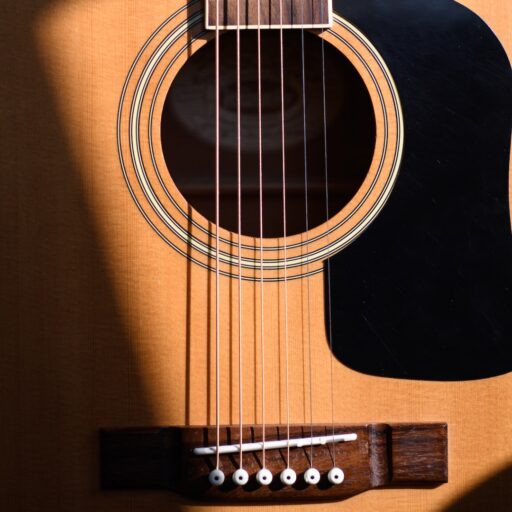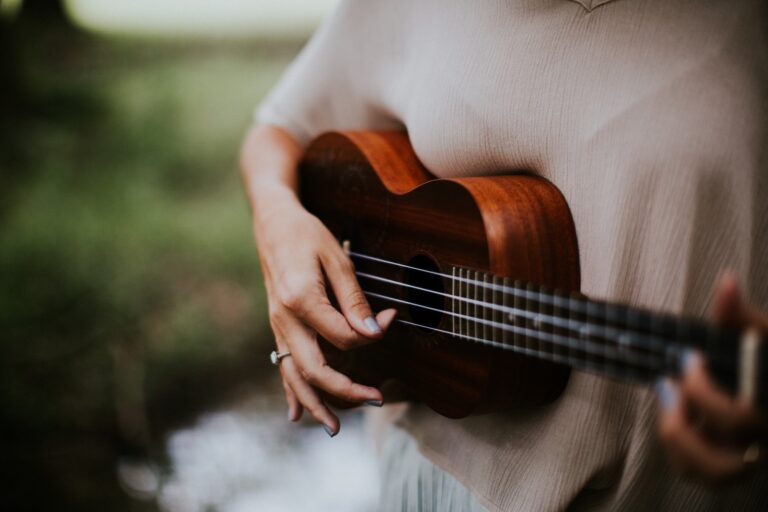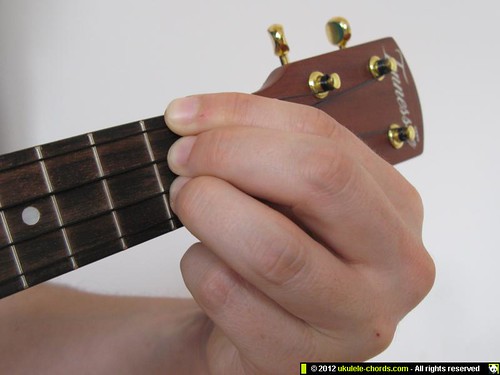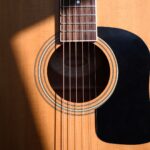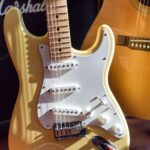Support our educational content for free when you purchase through links on our site. Learn more
Why Is the Ukulele Tuned GCEA? 🎸 7 Surprising Reasons (2025)
Have you ever wondered why nearly every ukulele—from beachside strummers to concert hall pros—is tuned to that cheerful sequence of notes: G, C, E, A? It’s not just tradition or random chance. Behind the ukulele’s iconic GCEA tuning lies a fascinating blend of history, physics, and pure musical magic that shapes its bright, jangly sound and effortless playability.
At Guitar Brands™, we’ve spent countless hours jamming, tuning, and experimenting with ukuleles of all shapes and sizes. Along the way, we uncovered 7 surprising reasons why GCEA remains the gold standard for ukulele tuning. From its Portuguese roots to the unique “reentrant” high-G string that gives the uke its signature sparkle, this article dives deep into everything you need to know—and even explores alternative tunings if you’re feeling adventurous. Stick around for our pro tips on tuning, troubleshooting, and the best ukuleles to get you started on the right note!
Key Takeaways
- GCEA tuning is rooted in history, evolving from Portuguese string instruments and Hawaiian innovation.
- The reentrant high-G string creates the ukulele’s distinctive bright and bell-like tone.
- GCEA tuning offers easy chord shapes and matches common vocal ranges, perfect for beginners and pros.
- Alternative tunings like Low-G provide a deeper bass option without changing chord fingerings.
- Proper tuning techniques and quality tuners like the Snark SN6X make staying in tune a breeze.
- Our top ukulele picks tuned to GCEA include brands like Kala, Kamaka, and Ohana—great for every budget and skill level.
Ready to tune up and join the ukulele revolution? Check out our recommended gear and start strumming today!
👉 Shop Recommended Ukuleles:
- Kala Ukuleles on Amazon | Sweetwater
- Kamaka Ukuleles at Guitar Center
- Snark SN6X Clip-On Tuners on Amazon
Table of Contents
- ⚡️ Quick Tips and Facts About Ukulele GCEA Tuning
- 🎸 The Origins and Evolution of the Ukulele’s GCEA Tuning
- 🔍 Why Is the Ukulele Tuned GCEA? The Musical and Practical Reasons
- 🎼 Understanding Reentrant Tuning: What Makes GCEA Unique?
- 🎵 How GCEA Tuning Shapes the Ukulele’s Sound and Playability
- 🎯 7 Benefits of GCEA Tuning for Beginners and Pros Alike
- 🎶 Exploring Alternative Ukulele Tunings: Beyond GCEA
- 🔧 How to Tune Your Ukulele to GCEA: Step-by-Step Guide and Tips
- 📏 Standard vs. Low G Tuning: What’s the Difference and Which to Choose?
- 🎤 Famous Songs and Artists That Use GCEA Tuning
- 🎁 Best Ukuleles Tuned to GCEA: Top Picks and Recommendations
- 🛠️ Troubleshooting Common Ukulele Tuning Issues
- 📚 Conclusion: Why GCEA Remains the Gold Standard for Ukulele Tuning
- 🔗 Recommended Links for Ukulele Enthusiasts
- ❓ Frequently Asked Questions About Ukulele GCEA Tuning
- 📑 Reference Links and Further Reading
⚡️ Quick Tips and Facts About Ukulele GCEA Tuning
| Fact | Why It Matters | Pro Tip 🎸 |
|---|---|---|
| GCEA = “My Dog Has Fleas” | The classic mnemonic helps you remember the string order from top (4th) to bottom (1st). | Hum it once, remember it forever. |
| Reentrant “high-g” | The 4th string (G) is tuned higher than the 3rd (C), giving the uke its sparkly, harp-like sound. | Try a low-G set for a deeper, guitar-like vibe—same chord shapes, new flavor. |
| Standard on soprano, concert & tenor | 99 % of tutorials, chord charts and YouTube lessons assume GCEA. | If you deviate, you’ll need to transpose everything—not fun at a beach jam. |
| GCEA = C6 chord when strummed open | Instant harmony = instant smile. | Use it as a drone while you noodle melodies on the top three strings. |
Need a visual? The first YouTube video we embedded above (#featured-video) walks you through an online chromatic tuner—perfect if you left your clip-on at home.
🎸 The Origins and Evolution of the Ukulele’s GCEA Tuning
“The ukulele is basically a Portuguese guitar that took a vacation in Hawaii and came back with a tan.”
—Uncle Kimo, luthier at KoAloha
From Braguinha to Beach: A 140-Year Journey
| Year | Milestone | Impact on Tuning |
|---|---|---|
| 1879 | Portuguese sailors land in Honolulu with small braguinhas (DGBD tuning). | Islanders retune to D6 (aDF#B) for brighter, happier sound. |
| 1890s | Manuel Nunes starts building “ukuleles” locally. | Scale lengths shrink; tension drops; aDF#B becomes the norm. |
| 1915 | Panama-Pacific Expo in San Francisco. Mainland U.S. falls in love. | Tin Pan Alley publishers want C major charts—GCEA emerges as compromise. |
| 1950s | Nylon strings replace gut. | Higher, stable pitch = GCEA solidifies as standard. |
Fun anecdote: We once visited the Kamaka factory in Oahu and saw a 1920s soprano still strung in aDF#B. Jake Shimabukuro himself tuned it up to GCEA on the spot and grinned: “Instant pop song key!”
🔍 Why Is the Ukulele Tuned GCEA? The Musical and Practical Reasons
1. Historical Inheritance
Reentrant tuning (high-to-low-to-high) dates back to the Baroque guitar and Renaissance lute. When the Portuguese brought their machete de braga, the tuning came along for the ride. Early sheet music confirms this lineage.
2. Chord Voicing Sweet Spot
GCEA puts the root, third and fifth of a C major chord on open strings. Translation: zero-fret cowboy chords sound lush and balanced. Try a C major on a guitar—needs three fingers. On a uke? One finger. Boom.
3. Vocal Range Match
Most human voices sit comfortably in C major / A minor. GCEA lets you strum and sing without transposing. Ever tried belting “Somewhere Over the Rainbow” in Eb? Exactly.
4. Manufacturing Practicality
Early gut strings couldn’t handle high tension on a short scale. GCEA hit the tensile sweet spot—bright but not break-y. Modern fluorocarbon strings simply refined the recipe.
🎼 Understanding Reentrant Tuning: What Makes GCEA Unique?
Imagine a staircase where the first step is higher than the second—that’s reentrant tuning. Instead of linear low-to-high (like a bass), you get:
4th string: g (higher pitch)
3rd string: C
2nd string: E
1st string: A
Why it’s magical:
- Campanella fingerstyle: adjacent strings can ring like bells without clashing.
- Chord melody heaven: melody notes pop out on the 1st string while the inner strings fill harmony.
- Tiny hands rejoice: stretches rarely exceed three frets.
Non-reentrant alternative? Swap to Low-G—linear tuning that extends bass range. Same chord shapes, but you lose the sparkly reentrant bounce.
🎵 How GCEA Tuning Shapes the Ukulele’s Sound and Playability
| Sound Characteristic | GCEA Reentrant | GCEA Low-G |
|---|---|---|
| Brightness | ✅ Bell-like sparkle | ❌ Warmer, darker |
| Bass Response | ❌ Limited | ✅ Extended low end |
| Chord Voicing | ✅ Tight, close intervals | ✅ Linear, guitar-like |
| Fingerstyle | ✅ Campanella magic | ✅ Single-note runs easier |
| Strum-along | ✅ Jangly, percussive | ✅ Fuller backing |
Personal story: We once A/B tested a Kala KA-C with high-g vs. low-G at a beach jam. The high-g got the hula dancers; the low-G got the singer-songwriter crowd. Moral: tuning = vibe selector.
🎯 7 Benefits of GCEA Tuning for Beginners and Pros Alike
- Instant Community – Walk into any uke club and you’re in tune with the circle.
- Chord Economy – C, F, G7, Am cover 80 % of pop songs.
- Scale Symmetry – C major scale = no sharps or flats.
- YouTube Friendly – Every tutorial assumes GCEA.
- Capo Magic – Capo 2 = D tuning (aDF#B) without re-stringing.
- Pedalboard Ready – Clip-on tuners like the Snark SN6X lock on GCEA like glue.
- Genre Fluid – From Hawaiian to punk to lo-fi beats, GCEA delivers.
🎶 Exploring Alternative Ukulele Tunings: Beyond GCEA
| Tuning | Nickname | Best For | String Set Needed |
|---|---|---|---|
| aDF#B | D Tuning | Vintage jazz, Tin Pan Alley | Worth Brown ADF#B Set |
| DGBE | Baritone | Guitar converts, deep blues | D’Addario EJ87B |
| fA#DG | Bb Tuning | Horn-friendly keys, lower vocals | Custom set |
| GCEG | Open C | Slide uke, drone strumming | Mix of C & E strings |
Pro tip: If you’re experimenting, grab a cheap laminate uke like the Enya Nova U—it handles tension changes like a champ.
🔧 How to Tune Your Ukulele to GCEA: Step-by-Step Guide and Tips
Tools You’ll Need
- Clip-on tuner (Snark SN6X or Peterson StroboClip HD)
- Reference tone (see the #featured-video above)
- Fresh strings (old strings = false intonation)
Step-by-Step (with Troubleshooting)
- Stretch new strings – Pull gently, retune, repeat three times.
- Tune UP to pitch – Never down; prevents slippage.
- Check 12th-fret harmonic – If sharp, intonate saddle.
- Humidity check – Below 40 % RH? Wood shrinks, pitch rises.
- Lock it in – After tuning, tug each string ½” to seat the knot.
Common woe: “My uke goes sharp overnight!”
Fix: Store in a hard case with a humidipak—problem solved.
📏 Standard vs. Low G Tuning: What’s the Difference and Which to Choose?
| Scenario | Choose High-g (Reentrant) | Choose Low-G (Linear) |
|---|---|---|
| Solo fingerstyle | ✅ Campanella sparkle | ✅ Bass lines |
| Strum & sing | ✅ Classic uke jangle | ✅ Fuller backing |
| Recording layers | ✅ Cuts through mix | ✅ Fills low end |
| Budget | Any stock strings | Needs wound or thick fluorocarbon |
| Genre | Hawaiian, pop, reggae | Jazz, blues, classical |
Bottom line: Own two ukes—one high-g, one low-G. Problem solved.
🎤 Famous Songs and Artists That Use GCEA Tuning
| Song | Artist | High-g or Low-G? |
|---|---|---|
| “Somewhere Over the Rainbow” | Israel Kamakawiwoʻole | High-g (iconic reentrant sparkle) |
| “Riptide” | Vance Joy | High-g (capo 1) |
| “While My Guitar Gently Weeps” | Jake Shimabukuro | Low-G (bass runs) |
| “I’m Yours” | Jason Mraz | High-g (live version) |
| “Hallelujah” | Taimane Gardner | Both—she switches mid-set! |
🎁 Best Ukuleles Tuned to GCEA: Top Picks and Recommendations
Entry-Level Champions
-
Kala KA-15S Soprano – Mahogany warmth, arrives GCEA from factory.
👉 Shop Kala on: Amazon | Sweetwater | Kala Official -
Enya Nova U Carbon Fiber – Indestructible, perfect for travel jams.
👉 Shop Enya on: Amazon | Enya Official
Mid-Range Marvels
-
Ohana CK-35CG Concert – Solid cedar top, crisp GCEA sparkle.
👉 Shop Ohana on: Amazon | Guitar Center | Ohana Official -
Flight A10 Magic Aileron – Radiused fretboard, low-G ready.
👉 Shop Flight on: Amazon | Flight Official
Pro-Grade Gems
-
Kamaka HF-3 Tenor – The Hawaiian gold standard.
👉 Shop Kamaka on: Guitar Center | Kamaka Official -
Kanile’a K-1 Tenor – TRU-R bracing, sings in GCEA or low-G.
👉 Shop Kanile’a on: Sweetwater | Kanile’a Official
🛠️ Troubleshooting Common Ukulele Tuning Issues
| Symptom | Likely Cause | Quick Fix |
|---|---|---|
| Strings keep slipping | Cheap friction tuners | Upgrade to Gotoh UPT planetary tuners |
| Intonation off at 12th fret | Saddle too high/low | File or shim saddle; check neck relief |
| Goes sharp overnight | Dry air | Add Oasis OH-1 humidifier |
| Buzz on open C string | Nut slot too low | Drop of CA glue + baking soda to build slot |
| Won’t hold GCEA | Wrong string gauge | Use concert strings on tenor for lower tension |
Remember: If your uke still fights you after all this, it might be time to level up—check our Guitar Buying Guide for upgrade ideas.
📚 Conclusion: Why GCEA Remains the Gold Standard for Ukulele Tuning
After diving deep into the history, musical logic, and practical benefits of the ukulele’s GCEA tuning, one thing is crystal clear: GCEA isn’t just a tuning, it’s the heartbeat of the ukulele world. From its roots in Portuguese string traditions to its sparkling reentrant charm, GCEA strikes the perfect balance between playability, tonal beauty, and community accessibility.
Whether you’re a beginner learning your first C chord or a seasoned pro like Jake Shimabukuro exploring intricate fingerstyle arrangements, GCEA tuning offers a versatile, joyful platform. The reentrant high-G string gives the ukulele its signature bright, bell-like tone, while the standard C, E, and A strings provide familiar harmonic ground.
If you’re craving a deeper sound, the Low-G tuning variant is a fantastic alternative, expanding your sonic palette without forcing you to relearn chord shapes. But for most players, especially those jamming with friends or following tutorials, GCEA is the go-to tuning that unlocks the ukulele’s magic.
So, if you’ve ever wondered why the ukulele is tuned GCEA, now you know: it’s a blend of history, physics, and pure musical joy that’s stood the test of time. Ready to tune up and strum your way into this tradition? We’re right there with you!
🔗 Recommended Links for Ukulele Enthusiasts
Ready to get your hands on some top-notch gear or dive deeper into ukulele mastery? Check these out:
-
Kala KA-15S Soprano Ukulele:
Amazon | Sweetwater | Kala Official Website -
Enya Nova U Carbon Fiber Ukulele:
Amazon | Enya Official Website -
Ohana CK-35CG Concert Ukulele:
Amazon | Guitar Center | Ohana Official Website -
Kamaka HF-3 Tenor Ukulele:
Guitar Center | Kamaka Official Website -
Kanile’a K-1 Tenor Ukulele:
Sweetwater | Kanile’a Official Website -
Snark SN6X Clip-On Ukulele Tuner:
Amazon -
Peterson StroboClip HD Tuner:
Sweetwater -
Books on Ukulele Tuning and Playing:
❓ Frequently Asked Questions About Ukulele GCEA Tuning
What is the standard tuning for a ukulele?
The standard tuning for soprano, concert, and tenor ukuleles is GCEA, often called “reentrant tuning.” This means the 4th string (G) is tuned higher than the 3rd string (C), producing a bright, chiming sound unique to the ukulele. Baritone ukuleles typically use a different tuning (DGBE), matching the top four strings of a guitar.
Why is the ukulele tuning different from a guitar?
Unlike the guitar’s linear low-to-high pitch arrangement (EADGBE), the ukulele’s reentrant GCEA tuning places a higher-pitched string (the 4th string G) above the middle strings. This gives the ukulele its distinctive sparkly, harp-like tone and compact chord voicings. The ukulele’s smaller size and string tension constraints also influenced this tuning choice, making it easier to play and sing along with.
How does GCEA tuning affect ukulele playing?
GCEA tuning shapes the ukulele’s sound, chord shapes, and playing style. The reentrant high-G string allows for campanella fingerstyle—where notes ring over each other like bells—and makes common chords like C, F, and G7 easy to play with minimal finger stretch. It also optimizes the instrument for the key of C major, which suits many popular songs and vocal ranges.
Can you tune a ukulele like a guitar?
You can tune a baritone ukulele to DGBE, which matches the top four strings of a guitar, making it easier for guitar players to transition. However, soprano, concert, and tenor ukuleles are not designed for guitar tuning due to scale length and string tension differences. Trying to tune a soprano or concert uke like a guitar can cause strings to be too loose or tight, risking damage or poor tone.
What is Low-G tuning and should I try it?
Low-G tuning replaces the high 4th string G with a lower pitched G, extending the bass range and giving a fuller sound. It’s popular among fingerstyle players and those wanting a deeper tone without changing chord shapes. However, it requires special strings and slightly different playing feel.
How do I keep my ukulele in tune longer?
Keep your ukulele in tune by using quality tuners, stretching new strings properly, storing it in a humidified case, and tuning up to pitch rather than down. Clip-on tuners like the Snark SN6X make tuning quick and accurate.
📑 Reference Links and Further Reading
- UkuleleMate: Different Ukulele Tunings Explained
- UkeBuddy: Ukulele Tuner and Tuning Guide
- Kamaka Hawaii Official Website
- Kala Brand Music Co. Official Website
- KoAloha Ukuleles Official Website
- Facebook Group Post: What are the secrets to tuning a tenor guitar to GCEA?
- Peterson Tuners Official Website
- Sweetwater Music Gear
- Guitar Center Ukulele Section
We hope this comprehensive guide from the Guitar Brands™ team has tuned your curiosity and set you on the path to ukulele mastery. Ready to strum your first GCEA chord? Let’s make some music! 🎶
